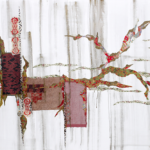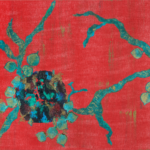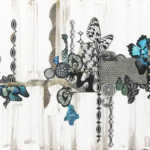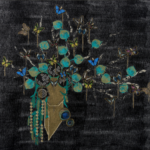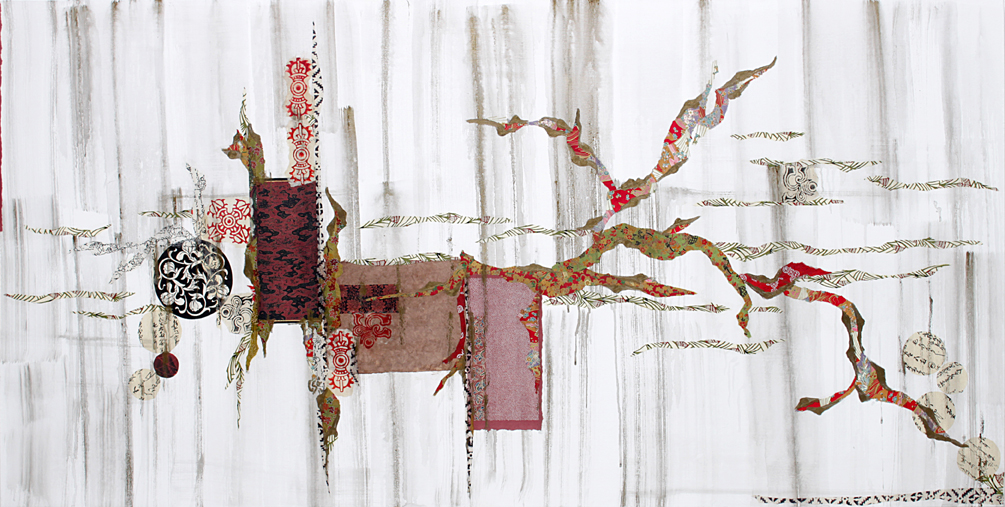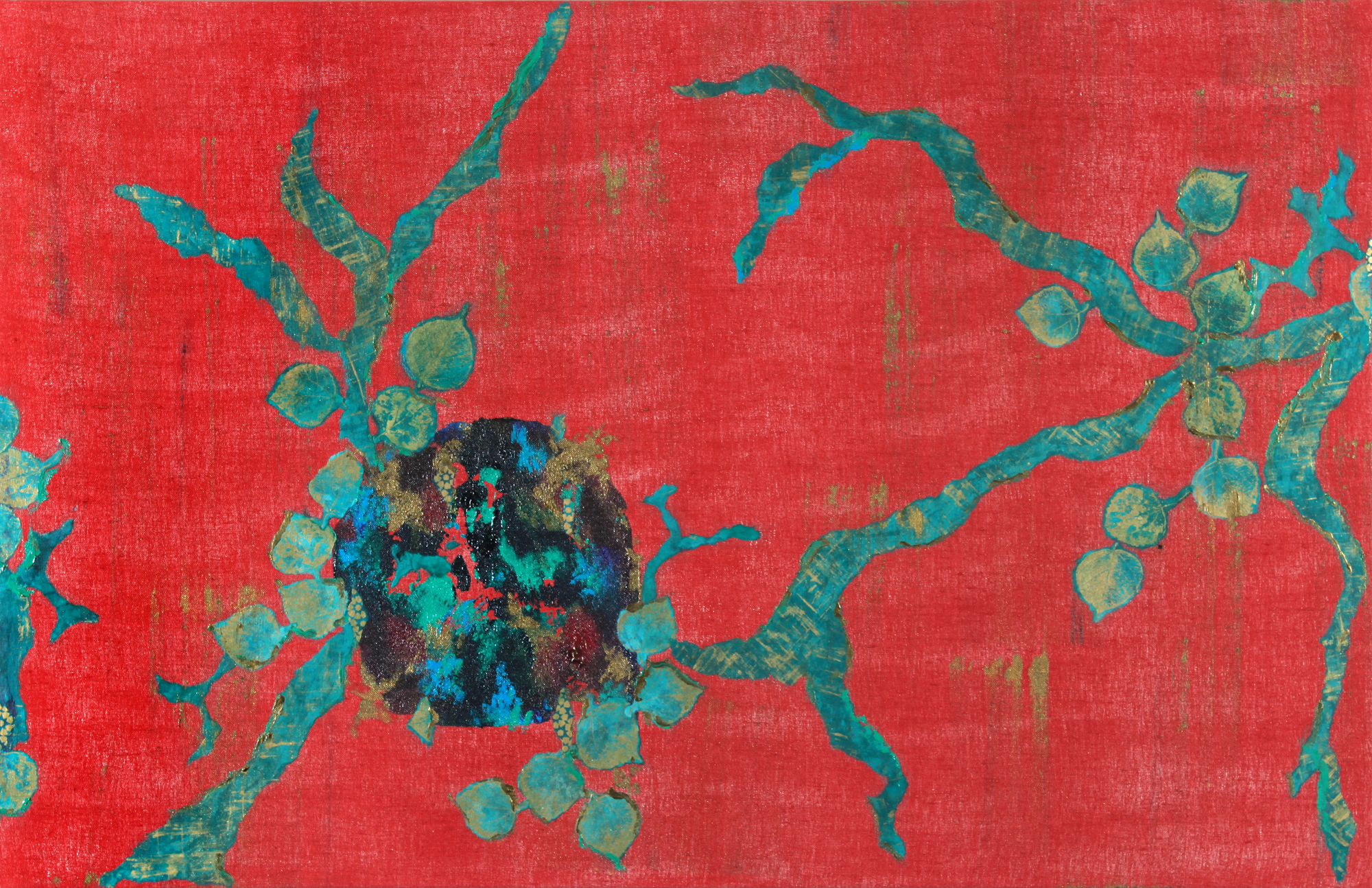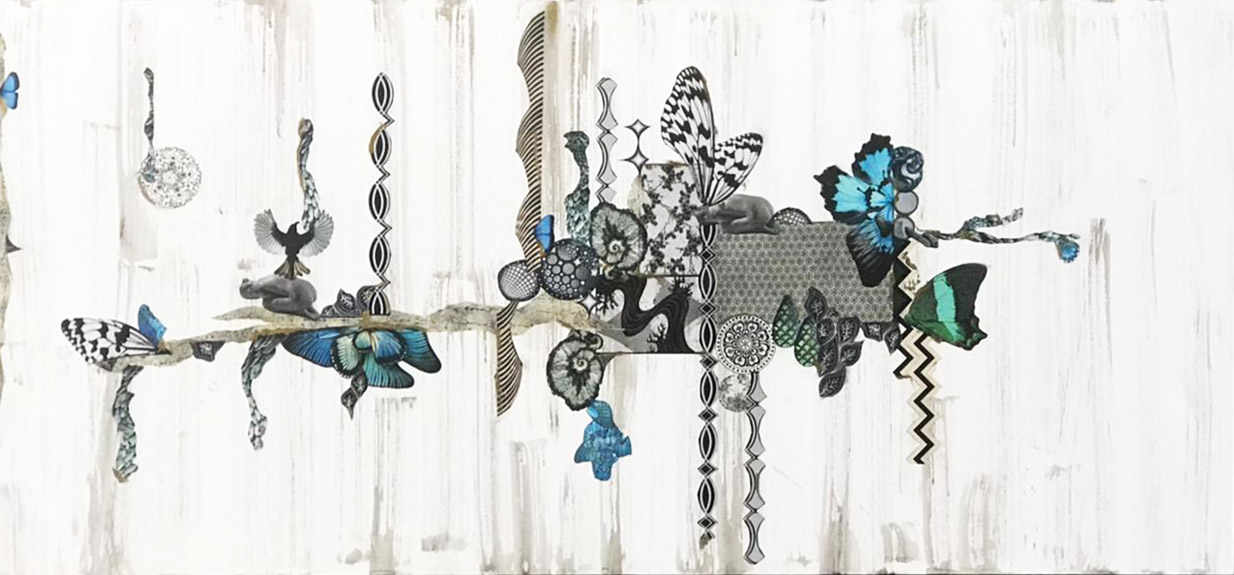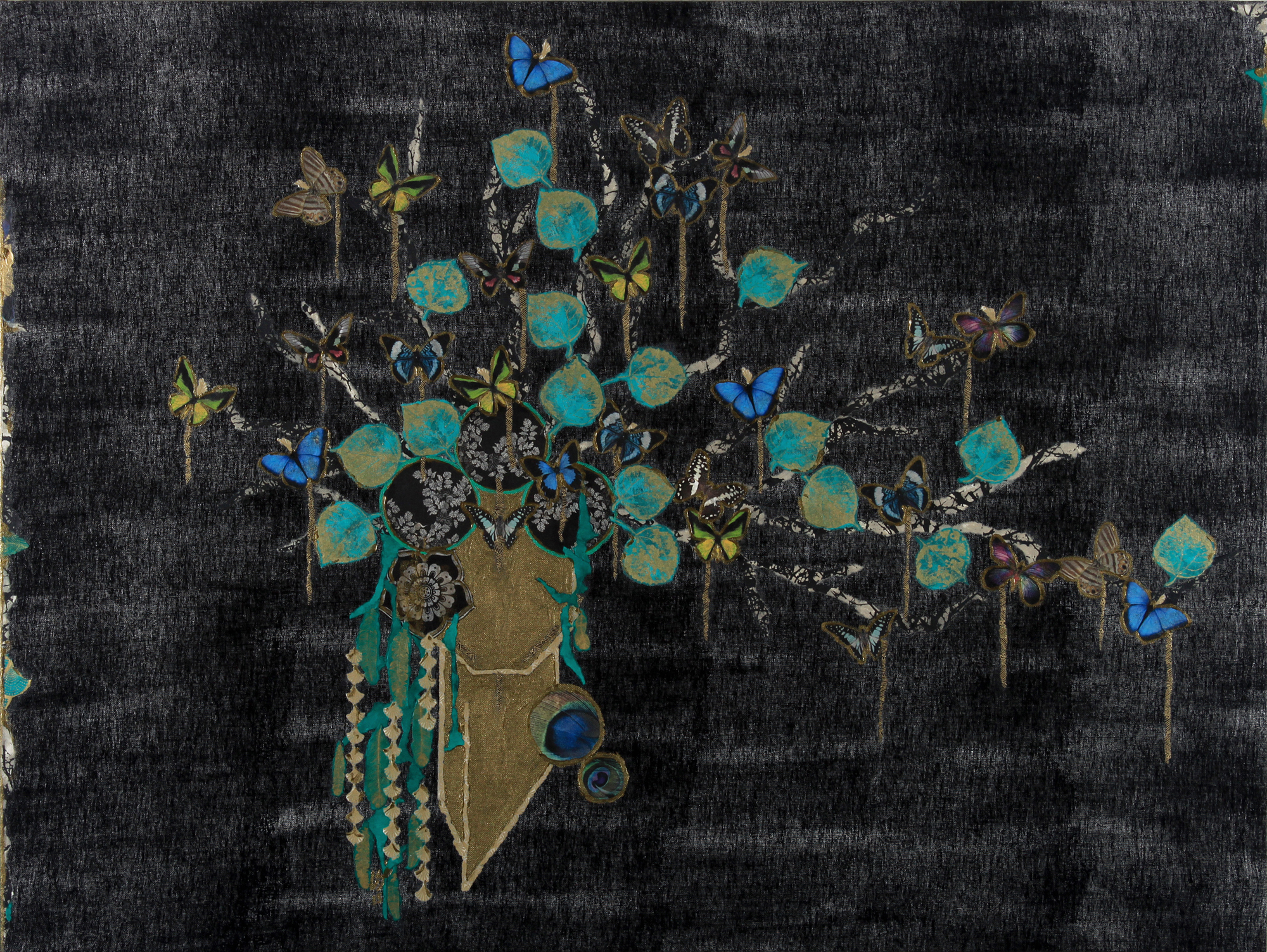What, firstly, catches the eye is the harmony coming from the forms that looks like plant images, for a spatial verticality. Seduced by what we are seeing, the integration of two worlds, the eastern and the western, the balance of the composition of layers, the brushstrokes and rythms, the use of strong colors with contrast of earth tones, or golden ones, unsettling, we directly relate with the works, by the most different sensations, that everyone agrees to call landscapes. Cristina Sá is a painter and drawer. Student of drawing, during teenage, with the artist Maciej Babinski, graduated, in 1979, in Interior Architecture and Art History from Escola Panamericana de Artes. She went on to study, in 1984, drawing and painting with professor Pedro Algaza. From 1989 to 1991 she set up her silk-painting atelier, first step in the professionalization. After that, she attended the atelier of the artist Jorge Franco during eight years, and concluded the watery, coal and pastel technique with the artis Philip Hallawell. Cristina Sá initiated in 1996, participating of collectives in São Paulo, city where most of her exhibitions are concentrated, and in Paris. In 1998, she carried out her first individual exhibitions in Salvador, Bahia; Búzios, Rio de Janeiro; and São Paulo, city where she exhibited her work again in 2002, 2004, 2006. Among her awards, she has won, in 2003, the Art Exhibition of the Société Académique “Arts-Sciences Lettres”, Paris, France; Salon Internacional de Monde de La Culture et des Arts, Cannes, France; 2004, Salon de la Société Nationale de Beaux Arts, Carrousel du Louvre, Paris, France; Salon Brasilis à Paris, Galerie François Marsad, Paris, France.
In your education, there are several drawing and painting techniques. Could you describe this trajectory? And in it, dedicate a little to talk about how you reached the silk-painting atelier, the professional start, I believe.
I study, or better yet, practice drawing and painting since my adolescence, and had the privilege of having as a professor the great artist Maciej Babinski. I’ve learned from him how to make woodcut, observation drawings using drypoint, coal, watercolor, and how to handle paints and paintbrushes. The place where we used to practice the “art of the art” was a large shed, with several types of materials at disposal to be used. I think this is what instigated me, since then, to try different formulas, new combinations and, at the same time, dedicate myself to the more technical, more accurate study of the drawing, the line. Along with this, the color and also their shades. The fabric is a material I really like, and painting in silk was a research that revealed new ways to me. Because of its flexibility, transparence and lightness, silk brings out a different response from paper when using lines and colors. Is this education essential so your work to go through, today, works in engraving, paintings, collages, or is it your own creation, the time of atelier, this moment, that makes its diversity?
Both things. The time in the atelier, surrounded by the materials I bring from trips around the world, mainly the Eastern, provide me with moments of delivery and intense creative processes, and these have a basis on my education. Knowledge of the techniques gives me freedom to fly, but it also brings a certain strictness, and it is in this conjunction where the identity of my work is. But the art also happens in life, on the streets, at any moment and any place of the world around us.
Still about you education, is that where your artistical research comes or arises from? Research we see in the use of papers, in the search for an opacity versus a transparency, in the golden tones, among others.
A good education gives you the basis to search for your own ways, own language. I think that from a certain mastery in the techniques, mainly in the drawing, the artist has the necessary consistency to seek his/her own personal language. There is the need for training the gaze. To see “well” helps us to better experience the artwork, feel it more, deepen yourself more. I research materials and, when I identify myself, I take over them, little by little, until they become an extension of myself. From some years ago, the image of the bamboo comes, delicate and strong at the same time; the oriental papers come, also fragile and dense; and in almost everything there are opposite forces, such as opacity and transparency. I feel the world today through the fusion between Eastern-Western, and this is always present in my work.
Regarding the last question: how do you see or feel the colors and tones in your work?
My palette is pretty varied. The colors used in larger or smaller scale give different vibrations to the works. Each work and each color has its own identity; I use very strong colors, reds, greens, purples, or earth tones, smoky ones, and naturally, the choice of colors causes different sensations for those who relate to the work. The golden, for example, which you mentioned before, may bring the glow of a pupil, a questioning tone and, sometimes, unsettling.
The criticism always refer to your work as landscapes. Landscapes built in the harmony between two worlds, the eastern and the western, the chinese engraving and baroque. What can you say about this opinion, do you agree with it or not, and what does it have as true or false, as its creator?
There is no true or false in the interpretation of an artwork. Every individual feels and expresses it in their own way, uniquely and freely. When I look at my work, the result of the finished artwork, and here I mention a detail, I don’t make sketches nor studies of anything, I release materials on the canvas, on papers, or any other basis, in an instinctive manner. After the work is finished, and this is an important moment in the process, to look and say: it’s finished. Then, I see they could be called landscapes, not necessarily connected to nature, they may be landscapes of the soul, of life, of dreams, of meetings and disagreements. And yes, always the Eastern-Western. This occurs with certain naturality in my veins, because I have a chinese ancestry. And this encounter, this merger, creates these landscapes that cause these visions of a world in upheaval, sometimes with a breeze of pure air, moments of harmoney that break apart next, and pull away as white and black keyboards separated, and that, sometimes, join together and make beautiful chords.
In our perspective, there is a harmony in your works. About the forms, that look like plants, their verticality, that we may call figures, there is a brushstroke and a rhythm that let themselves be perceived in the balance of the composition of planes – Eastern-Western merger. Can you say something about your visual poetry? About how your visual poetry is made?
My visual poetry is fed, mainly, by my spirit, added to the exercises and researches, uneasiness of lines, colors, forms, miscellaneous materials. I work with papers almost all the time ripping them apart, which gives them the feeling of loose, gestural brushstrokes. Oriental papers are quite fibrous and bind among themselves or with canvas linen forming a sole body, with the work layers overlapping, paint, Indian ink, paper, watercolor, monotypes… There is no way to know where one thing starts and the other one ends, everything blends together, merges. I don’t like to exhaust the work background; everything becomes one thing only, the composition as a whole, but I try to always let a “space” for the eye to rest, penetrate in dense and thick compositions, delicate and condensed forms that, subsequently, dilute themselves, rest or search for another meeting.
What are the important references or influences in your career as an artist? And what do you feel of some of them as a quotation within your works? There are a lot of direct and indirect influences.
Throughout the history of arts, several artists fascinate me: Gustav Klimt, Matisse, Egon Schiele, Qing Qing, Mira Schendel, Lygia Clark, Regina Silveira, Cildo Meireles, among many others. But they are subtle influences, I don make “quotations” in my works. There is a thin line that separates my work from these influences.
For those who contemplate your work, time is of seduction. They seduce our look. But for the artist, there is a time of creation. How is this time made for you? And still about time, how do you feel your work in the present time of the Brazilian artwork?
I do my work with no rush. The creative process happens in the most unexpected hours or sometimes, as a consequence of being connected with the lonely space of my atelier, with my songs, my thoughts. The techniques used are, sometimes, well developed and slow, but, at some stages of the work, the rhythm is accelerated and made with a lot of energy, delivery and vibration. I keep in my mind a very simple, but extremely complex sentence: “Art is a companion”. I start from the principle that when we are in contact with an artwork, we are never alone. This role of a companion that the art may take on for each one of us may unfold in millions of aspects, such as images in a kaleidoscope. A good companion may be the one that calms, instigates, unsettles, questions, provokes, stimulates or seduces us! It may turn us inside out, push, pull or let us go! I think the art should fulfill this role with each individual that somehow gets in touch with it. This says a little about how I’d like my work to be fitted in the present time.
A dismantling of question eight: How do you see the Brazilian art currently?
Firstly, I see Brazilian art totally inserted and well placed within the international setting. I visit, whenever I can, art galeries and exhibits here and abroad, and I feel very proud of several of our artists. There are, in my opinion, however, some serious misconceptions about what is called art nowadays. But this is a separate issue, completely polemic, and it is an international matter.
In your career, there is an exhibition in Bahia, in 1998. Now, there is your coming back. How do you feel this contact of your work today with Bahia?
I can say for sure that there isn’t a place more seductive, more alluring than Bahia. Bahia has poetry, literature, art, music, rhythm, batuque, aromas, flavors, mistery, history and “stories”, magic and seduction. I feel a great joy in being able to bring my work again to a place with such sensitivity in the air!
(Interview/see dates page)


